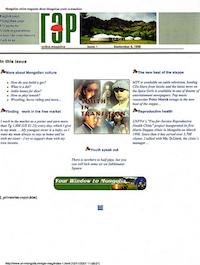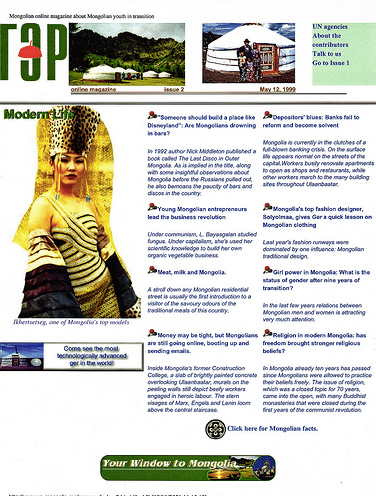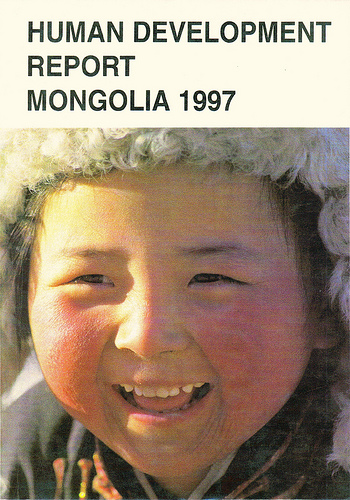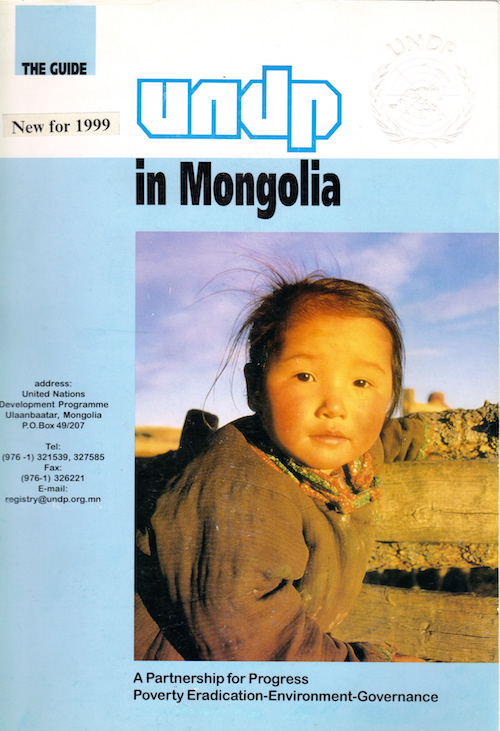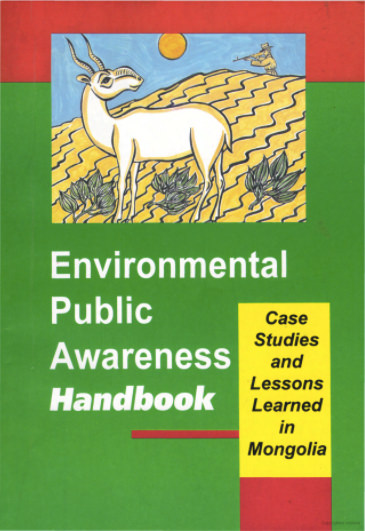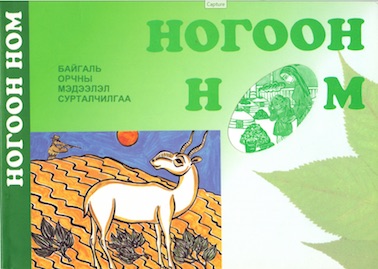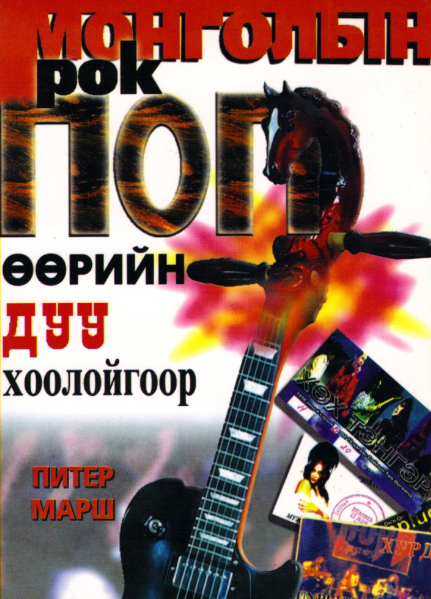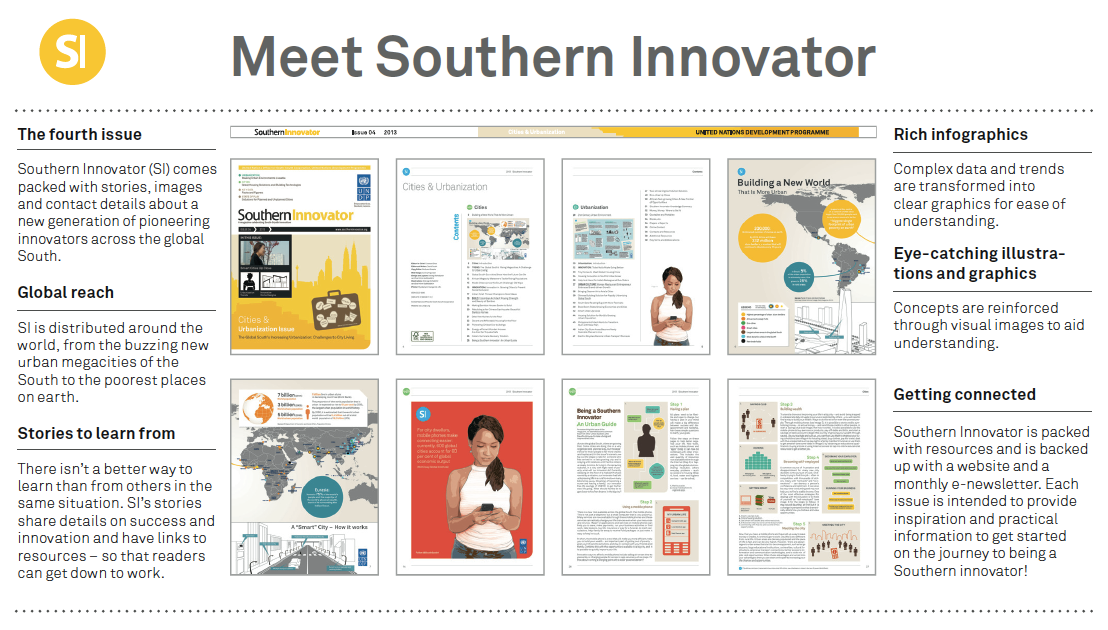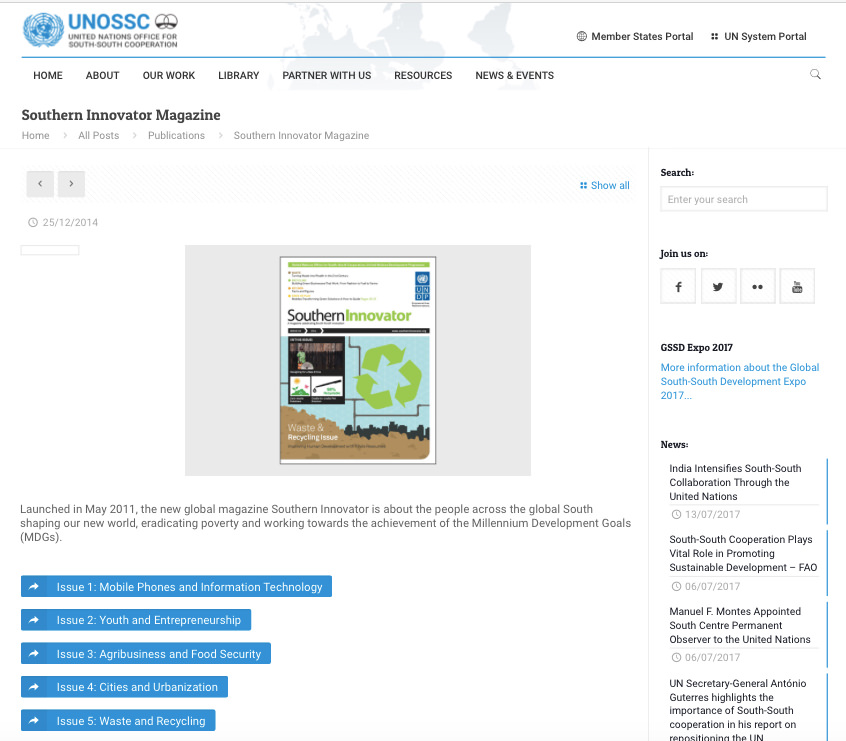Ger: Mongolia’s First Web Magazine (and a pioneering web project for the United Nations) | 12 January 2016
 Tuesday, January 12, 2016 at 11:35AM
Tuesday, January 12, 2016 at 11:35AM
"The years 1998 and 1999 have been volatile ones for Mongolia, with revolving door governments, the assassination of a minister, emerging corruption, a banking scandal, in-fighting within the ruling Democratic Coalition, frequent paralysis within the Parliament, and disputes over the Constitution. Economically, the period was unstable and rife with controversies." Mongolia in 1998 and 1999: Past, Present, and Future at the New Millennium by Sheldon R. Severinghaus, Asian Survey, Vol. 40, No. 1, A Survey of Asia in 1999 (Jan. - Feb., 2000). pp. 130-139 (Publisher: University of California)
Ger Magazine was launched on September 9, 1998 (Ger is the Mongolian word for both the traditional tent dwelling and home). The theme of youth in the transition was explored by a combined team of Mongolian and foreign journalists. The Ger Magazine project had basically three goals: first, raise the quality of journalism in the country, secondly, introduce the country to a wider global audience and, thirdly, by being the country’s first online magazine, prove the internet was an effective way to communicate.
Issue 1
Issue 1 of the magazine investigated what life was like for youth during the transition years (post-1989). Stories tackled the struggle to find work in the free market, the booming pop music scene and how it is leading the way in business entrepreneurship, reproductive health, the basics on Mongolian culture, and vox pop views from Mongolian youth.
Issue 2
Issue 2 of the magazine investigated modern life in Mongolia during transition. The team of journalists were hitting their stride by this issue. Stories probed the proliferation of bars and the problem of alcoholism, corrupt banking practices and the loss of savings, how the young were the country’s leading entrepreneurs, Mongolia’s meat and milk diet, “girl power” and the strong role played by women, the burgeoning new media, the rise and rise of Buddhism, and Mongolia’s dynamic fashion designers (this article inspired foreign fashion designers to embrace the Mongolian 'look' in the next season’s designs).
Editor-in-Chief: David South, UNDP Communications Coordinator
Editor: A. Delgermaa, UB Post newspaper
Translation: A. Delgermaa
Photography: N. Baigalmaa, David South
Design and layout: B. Bayasgalan, UN Homepage Webmaster
"This is the second issue of Ger. We have chosen the theme "Modern Life" to introduce people outside of Mongolia to the complexities of life in today’s Mongolia – the good, the bad and the ugly as a cowboy film once said. Ger is a project that draws upon the best journalists of this country. Under democracy Mongolia enjoys a flourishing free press, with over 800 officially registered newspapers for a population of 2.4 million! Ger has chosen A. Delgermaa of the UB Post newspaper to edit this issue. The UB Post is one of two English language newspapers in Mongolia and is owned by the Mongol News Company, a publisher of five newspapers, including the daily Today newspaper. Ger is a project to improve the quality of journalism in Mongolia, while introducing the people of the world to Mongolian journalists and this wonderful country. We hope you enjoy this issue of Ger. Please send us your comments.
Ger is not an official UNDP publication but a project to improve the quality of journalism. Opinions expressed in the magazine do not necessarily reflect the official views or policies of the United Nations Development Programme. Articles may be freely reproduced so long as credit is given and the editors are notified. Ger is published in English and Mongolian.
Contributors
Ms. A Delgermaa: A reporter with the UB Post English weekly newspaper, which enjoys a good reputation among readers. Delgermaa is a young journalist and started her career in 1997, after graduating from the English Department of the Foreign Service School, Mongolian National University. She is a regular contributor to UN publications and has been published by Inter Press Service. She thinks Mongolia needs more psychologists to give courage to those many who are yearning for a better life. Like many young Mongolians she also wants to study abroad, to learn how journalism is practised in other countries.
Ms. N. Oyunbayar: Also a reporter with the UB Post newspaper, Oyunbayar, is a graduate of Ekaterinburg University in Russia, where she qualified as a Russian language teacher. She left her pupils in Sukhbaatar aimag, where she was born, some years ago and decided to undertake a personal crusade against wrongdoing by becoming a journalist for the UB Post. She is an award-winning journalist and a member of the Mongolian Free Democratic Journalists Association. She loves to cook and enjoys learning about new cuisines.
Ms. T. Mandala: A historian and journalist, she is a reporter with the "Weekend" weekly newspaper. She has been a journalist for two years, has written several interesting interviews with politicians, including the Mongolian parliamentary speaker R. Gonchigdorj and MPs Da. Ganbold and E. Bat-Uul. She explores issues like life after death and she wants to be a public defender in a court one day.
She is a successor of her grandfather Khodoogiin Perlee, who is a famous historian in Mongolia. And studies religion, especially Buddhism and Shamanism.
Mr. D. Dorjjav: A psychologist and a lecturer at the Administrative Management Department of Mongolian National University, he is married and has two girls and a boy. He is currently working on his doctoral thesis. His wish is to help people to open themselves up and discover their abilities. His plan for the future is to contribute to the psychological understanding of life in Mongolia. Dorjjav’s hobby is to talk to people and exchange opinions.
G. Enkhtuya: Born in the year of the pig (there are twelve years in the lunar calendar), a professional in marketing, trading, journalism, she is currently studying lawsin the Institute of Legal Studies, Mongolian National University. She is also a reporter for Odriin Sonin independent daily newspaper, once the largest state-ownednewspaper until the start of 1999. She likes to cook when she is liberated from her official duties.
Jill Lawless: An Honourary Foreign Member of the Mongolian Free Democratic Journalists Association, Jill has been the editor of the UB Post newspaper since 1997. Jill regularly contributes to Agence France-Presse, Far Eastern Economic Review, Deutsche Welle and the Canadian Broadcasting Corporation. She is happiest riding camels in the Gobi desert.
Michael Kohn: Michael is the editor of the Mongol Messenger and contributed to the first edition of Ger. He is a regular contributor to Associated Press and the Far Eastern Economic Review. Michael is an avid traveler and is an expert on hitchhiking across Mongolia.
Ms. N. Baigalmaa: Photo journalist for Onoodor (Today) newspaper, the number one independent newspaper for three years. "Photo journalism is always interesting. I really enjoy taking action photos." She is fed up of taking photos of static photos of people standing or sitting and has devoted her life to photo journalism. One never boring thing for her is her two sons and a girl. Sometimes she loses her sports jacket to her oldest son, now taller than her."
Impact
The stories have been featured in many books on the country, and the magazine was recommended as a good resource by the Lonely Planet guidebook.
This was not only the first publication of its kind in the UN, it was also a pioneering online venture and remarkable for a country lacking the advantages of wealthier countries.
An online survey of the state of Mongolia’s media and its history (www.pressreference.com/Ma-No/Mongolia.html), had this to say: “An interesting variation from some of the other publications available is Ger Magazine (published online with guidance from the United Nations Development Program, UNDP), which is concerned with Mongolian youth in cultural transition. The name of the magazine is meant to be ironic because a ger is the Mongolian word for yurt—a yurt being traditional nomadic housing—but the magazine is about urbanization and globalization of Mongolian youth.”
Citations
A Complete Guide on Celebrations, Festivals and Holidays around the World by Sarah Whelan, Asteroid Content, 2015
Gale Directory of Publications and Broadcast Media by Jeff Summer, Gale Group, 2001
Mongol Survey, Issue 8, The Society, 2001
Mongolian Culture and Society in the Age of Globalization by Henry G. Schwarz (editor), Center for East Asian Studies, Western Washington University, 2006
Nations in Transition: Mongolia by Jennifer L. Hanson, Infobase Publishing, 2003
Teen Life in Asia by Judith J. Slater, Greenwood Publishing Group, 2004
World Press Encyclopedia: A Survey of Press Systems Worldwide, Volume 1 by Amanda C. Quick, Gale Group, 2003
Some of the team behind Ger:
Editor-in-Chief: David South
Logo Design: P. Davaa-Ochir
Layout and Online: B. Bayasgalan
Contributors: A. Delgermaa, Michael Kohn, Jill Lawless, Peter Marsh, and N. Oyuntungalag.
Read the Wikipedia entry here: en.wikipedia.org/wiki/Ger_magazine
Read the full content by searching the www.archive.org wayback machine via the www.un-mongolia.mn website: https://web.archive.org/web/19990420090143/http://www.un-mongolia.mn/
 1998,
1998,  1999,
1999,  A. Delgermaa,
A. Delgermaa,  B. Bayasgalan,
B. Bayasgalan,  David South,
David South,  Editor-in-Chief,
Editor-in-Chief,  Jill Lawless,
Jill Lawless,  Michael Kohn,
Michael Kohn,  Oyuntungalag,
Oyuntungalag,  Peter Marsh,
Peter Marsh,  UNDP Mongolia,
UNDP Mongolia,  ger magazine in
ger magazine in  Agenda 21,
Agenda 21,  Asian Financial Crisis,
Asian Financial Crisis,  Corruption,
Corruption,  David South Consulting,
David South Consulting,  Digital,
Digital,  Douglas Gardner,
Douglas Gardner,  Emerging Markets,
Emerging Markets,  Finance,
Finance,  Geopolitics,
Geopolitics,  Health and Human Development,
Health and Human Development,  ICT4D,
ICT4D,  International Development,
International Development,  Knowledge Sharing,
Knowledge Sharing,  Media,
Media,  Millennium Development Goals,
Millennium Development Goals,  Nobel Peace Prize,
Nobel Peace Prize,  UNDP Mongolia,
UNDP Mongolia,  Youth
Youth 